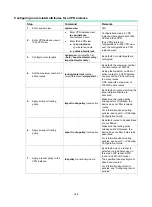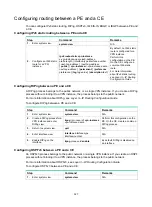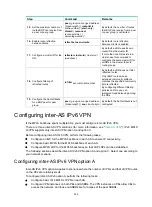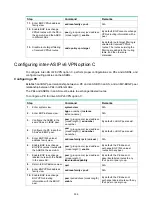
338
Step Command Remarks
4.
Specify the VPN
instances for forwarding
the matching packets.
apply access-vpn vpn-instance
vpn-instance-name
&<1-n>
By default, no VPN instance is
specified.
You must specify multiple VPN
instances for the node. The first one
is the VPN instance to which the
multirole host belongs, and others
are the VPN instances to be
accessed by the multirole host. A
matching packet is forwarded
according to the routing table of the
first VPN instance that has a
matching route for that packet.
The value for
n
is 4.
5.
Return to system view.
quit
N/A
6.
Enter the view of the
interface connected to
the CE.
interface
interface-type
interface-number
N/A
7.
Apply the policy to the
interface.
ipv6 policy-based-route
policy-name
By default, no policy is applied to the
interface.
Configuring an IPv6 static route
Step Command
Remarks
1.
Enter system
view.
system-view
N/A
2.
Configure an IPv6
static route for a
VPN instance to
reach the multirole
host.
ipv6 route-static
vpn-instance
s-vpn-instance-name
ipv6-address
prefix-length
vpn-instance
d-vpn-instance-name nexthop-address
[
permanent
] [
preference
preference
] [
tag
tag-value
] [
description
text
]
By default, no IPv6 static routes
are configured.
The
d-vpn-instance-name
argument represents the VPN
instance to which the multirole
host belongs. The
next-hop-address
argument
represents the IPv6 address of
the CE in the site where the
multirole host resides.
Configuring an OSPFv3 sham link
Before you configure an OSPFv3 sham link, configure basic IPv6 MPLS L3VPN (OSPFv3 is used
between PE and CE).
Configuring a loopback interface
Step Command
Remarks
1.
Enter system view.
system-view
N/A
2.
Create a loopback interface
and enter loopback interface
view.
interface loopback
interface-number
By default, no loopback
interfaces exist.






























